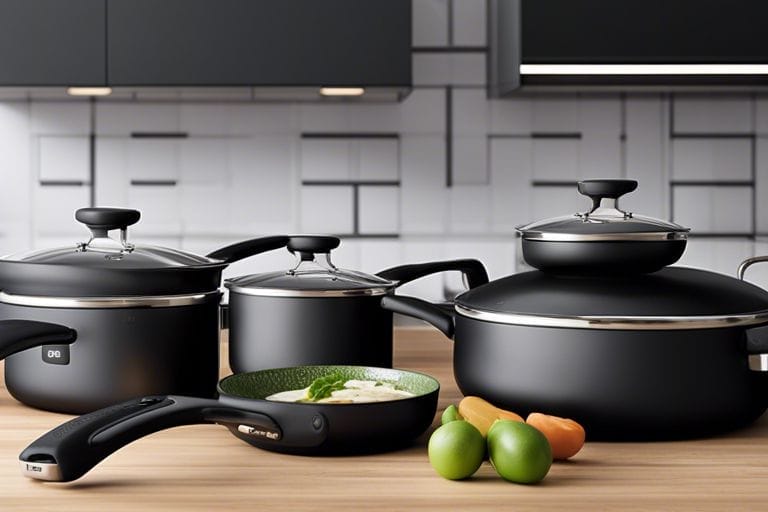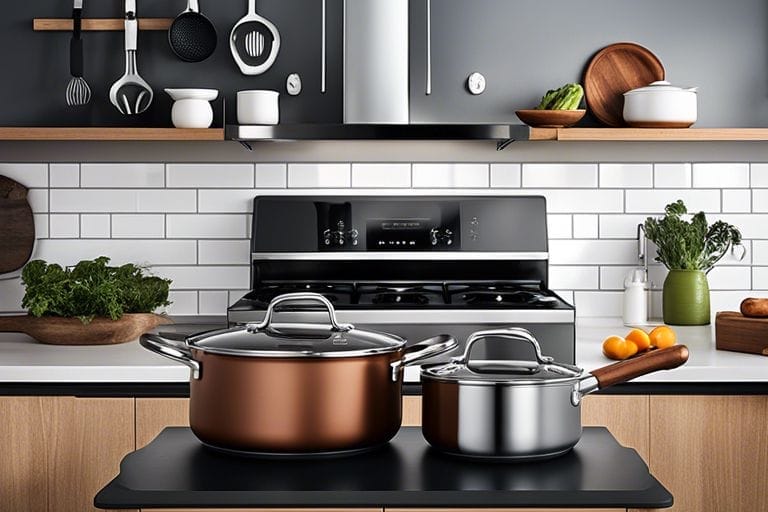Curious about whether non-stick cookware is actually safe for your health? You’re not alone. With so much conflicting information out there, it’s important to have a clear understanding of the potential risks and benefits of using non-stick pots and pans in your kitchen. Studies have shown that the chemicals used to create the non-stick coating, such as perfluorooctanoic acid (PFOA) and polytetrafluoroethylene (PTFE), can release toxic fumes when heated at high temperatures. These fumes can pose serious health risks, including respiratory issues and even flu-like symptoms, leading many to question the safety of using non-stick cookware. However, when used properly and at lower temperatures, non-stick cookware can offer convenience and easy clean-up. In this blog post, we’ll delve into the truth about non-stick cookware and provide you with the information you need to make informed decisions about your kitchen equipment.
Key Takeaways:
- Non-stick coatings can be safe for cooking: While there has been concern about the safety of non-stick cookware, when used properly and maintained correctly, non-stick coatings can be safe for cooking.
- High temperatures can release harmful fumes: Overheating non-stick cookware can lead to the release of harmful fumes, so it’s important to use them at moderate temperatures and avoid preheating empty pans.
- Regular maintenance is crucial: Proper care and maintenance of non-stick cookware, such as avoiding using metal utensils and cleaning with non-abrasive materials, can help prolong its safety and effectiveness.
Understanding Non-Stick Surfaces
Now, let’s delve into the world of non-stick surfaces. Non-stick cookware is designed to prevent food from sticking to the pan during cooking, making it easier to clean up afterward. These surfaces are typically coated with a material called polytetrafluoroethylene (PTFE) or another synthetic compound known as perfluorooctanoic acid (PFOA).
Composition of Non-Stick Coatings
Non-stick coatings are made up of a mixture of fluoropolymers that provide the slippery surface, making it difficult for food to stick. However, some traditional non-stick coatings contain PFOA and other potentially harmful chemicals that can be released into the air and food when overheated. Exposure to these chemicals has been linked to health issues such as cancer and other adverse health effects.
How Non-Stick Coatings Are Applied to Cookware
When it comes to applying non-stick coatings to cookware, the process involves spraying a liquid coating onto the metal surface of the cookware, followed by curing in an oven. This process creates a durable bond between the non-stick coating and the cookware, ensuring that the non-stick surface is long-lasting. However, overheating non-stick cookware can result in the release of toxic fumes, which can pose health risks to you and your family.
By understanding the composition and application of non-stick coatings, you can make informed decisions about the safety of your cookware and take necessary precautions to protect yourself and your loved ones from potential health hazards. It’s important to weigh the convenience of non-stick cookware against the potential risks associated with its use. Stay informed and vigilant when it comes to your cooking tools to ensure a safe and healthy cooking environment for you and your family.

Health Concerns and Safety Measures
Obviously, the safety of non-stick cookware is a major concern for many people. While non-stick coatings have made cooking and cleaning easier, there are health concerns associated with the chemicals used to create these coatings. However, with the proper knowledge and safety measures, you can still enjoy the convenience of non-stick cookware without compromising your health.
Chemicals of Concern in Non-Stick Coatings
One of the main chemicals of concern in non-stick coatings is perfluorooctanoic acid (PFOA), which has been linked to various health issues, including cancer. Additionally, when non-stick coatings are overheated, they can release toxic fumes that are harmful when inhaled. It is important to note that PFOA has been phased out of production in the US since 2013, and most non-stick cookware is now PFOA-free. However, other chemicals such as perfluorinated compounds (PFCs) are still used in non-stick coatings, so it’s essential to choose cookware that is labeled as PFOA-free.
Temperature Thresholds and Overheating Risks
When using non-stick cookware, it’s crucial to be mindful of temperature thresholds to avoid overheating the coating. Overheating can lead to the release of toxic fumes and the degradation of the non-stick surface, compromising its effectiveness. For example, the maximum recommended temperature for most non-stick cookware is around 500°F (260°C). Exceeding this temperature can pose health risks and cause irreparable damage to the non-stick coating.
Chemicals of Concern in Non-Stick Coatings
| PFOA | Linked to health issues, including cancer, phased out of production in the US since 2013 |
| PFCs | Used in non-stick coatings, choose cookware labeled as PFOA-free to minimize exposure |
Temperature Thresholds and Overheating Risks
| Maximum Temperature | Most non-stick cookware has a recommended temperature threshold of 500°F (260°C) |
| Overheating Risks | Exceeding the maximum temperature can lead to toxic fumes and degradation of the non-stick coating |
Alternatives to Traditional Non-Stick Cookware
Despite the potential health risks associated with traditional non-stick cookware, there are several safer alternatives that you can consider for your cooking needs. If you are concerned about the safety of non-stick cookware, it may be time to explore other options that are better for your health and the environment. You can find a comprehensive list of the best non-toxic cookware options in this Best Non-Toxic Cookware: Teflon vs. Ceramic Reviews, ….
Ceramic Coated Cookware
If you are looking for a non-stick alternative, ceramic coated cookware is a popular choice. Ceramic coatings are made from natural materials and do not contain PFOA or PTFE, making them a safer option for your cooking needs. They are also non-reactive, which means that they will not release harmful chemicals into your food. Additionally, ceramic cookware is known for its excellent heat distribution and retention, making it a versatile and durable choice for your kitchen. When properly cared for, ceramic cookware can provide you with non-stick cooking surfaces without the potential health risks associated with traditional non-stick options.
Seasoned Cast Iron and Stainless Steel Options
Another alternative to traditional non-stick cookware is seasoned cast iron and stainless steel options. These materials have been used for cooking for centuries and are known for their durability and versatility. Seasoned cast iron cookware, in particular, develops a natural non-stick surface over time with proper seasoning and care. Stainless steel cookware is also a safe and durable option for your kitchen, and it does not release any harmful chemicals into your food. By choosing seasoned cast iron or stainless steel cookware, you can avoid the potential health risks associated with traditional non-stick options and enjoy the benefits of natural, non-toxic cooking surfaces in your kitchen.
Best Practices for Safe Non-Stick Cooking
Not all non-stick cookware is created equal, and it’s important to take certain precautions to ensure that you are using it safely. While many people worry about the safety of non-stick coatings, especially when they begin to show signs of wear and tear, there are steps you can take to minimize any potential risks. To find out more about the safety of non-stick cookware, you can read about it here in our article ‘Is Graphite Cookware Safe? Unveiling the Truth’.
Proper Usage and Care for Non-Stick Cookware
When it comes to using non-stick cookware safely, it’s important to remember that high heat can break down the non-stick coating, releasing harmful chemicals into your food. To prevent this, it’s best to cook over low to medium heat and avoid using metal utensils that can scratch the coating. Always hand wash your non-stick cookware with a soft sponge and mild detergent to prevent damage. By following these best practices, you can extend the life of your non-stick cookware and minimize any potential health risks.
Recognizing When to Replace Your Non-Stick Cookware
Over time, the non-stick coating on your cookware may wear down, leading to potential health hazards. If you notice any peeling, chipping, or scratching on the surface of your non-stick cookware, it’s time to replace it. Cooking with damaged non-stick cookware can expose you to harmful chemicals that can leach into your food. By replacing your cookware when it shows signs of wear, you can ensure that you are cooking safely and healthily.

Is Non-Stick Safe for Cooking? The Truth Unveiled
Presently, you have learned about the potential risks of non-stick cookware and the importance of using it properly. It is crucial to be aware of the dangers of overheating non-stick pans and using metal utensils on them. By taking proper precautions and investing in high-quality non-stick cookware, you can minimize any potential health risks and continue to enjoy the convenience of non-stick cooking. Remember to always follow the manufacturer’s instructions for use and care, and consider alternative options such as ceramic or stainless steel cookware for added peace of mind. With this knowledge in hand, you can confidently make informed choices when it comes to your kitchen cookware.
Is Non-Stick Safe for Cooking? The Truth Unveiled
Q: What are non-stick cooking surfaces made of?
A: Non-stick cooking surfaces are typically made with a coating of polytetrafluoroethylene (PTFE), also known as Teflon, or ceramic. PTFE-based non-stick coatings are known for their excellent non-stick properties, while ceramic coatings are praised for being more environmentally friendly.
Q: Are non-stick cooking surfaces safe to use?
A: When used properly and not overheated, non-stick cooking surfaces are safe to use. However, at high temperatures, non-stick coatings can release toxic fumes that may pose health risks. It is important to follow the manufacturer’s instructions and avoid overheating non-stick cookware. Additionally, some studies suggest that long-term exposure to PTFE and PFOA, a substance used in the production of PTFE, may have potential health risks.
Q: How can I safely use non-stick cookware?
A: To safely use non-stick cookware, it is important to use them at low to medium heat settings and avoid cooking methods that require high temperatures, such as searing and broiling. Use wooden or silicone utensils to prevent scratching the non-stick coating, and hand wash the cookware with a soft sponge and mild detergent. Consider using alternative cookware materials, such as stainless steel or cast iron, for high-heat cooking. Regularly inspect non-stick cookware for signs of wear and tear, and replace them if the coating is scratched or peeling.

